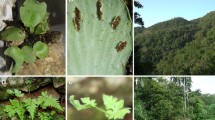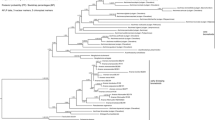Abstract
The Neotropical genus Bromeliophila includes two species that grow exclusively in the water-filled leaf axils of Bromeliaceae. Phylogenetic analyses of a three marker dataset (chloroplast genome rbcL gene and trnL-F region, and nuclear ribosomal ITS1-5.8S-ITS-2 region) confirmed the monophyly of Bromeliophila and provided evidence for a sister relationship of Bromeliophila and Prionolejeunea; this clade is in turn sister to Cyclolejeunea. Despite remarkable morphological similarities, Bromeliophila is not closely related to Lejeunea and its close relatives Harpalejeunea and Microlejeunea. Based on the molecular topology and morphological evidence, Cyclolejeunea is subdivided in subgenus Cyclolejeunea and the monospecific subgenera Hyalolejeunea and Nephrolejeunea. Genetic relationships among multiple accessions of the same species support currently accepted morphological–typological species concepts.




Similar content being viewed by others
References
Altschul SF, Gish W, Miller W, Myers EW, Lipman DJ (1990) Basic local alignment search tool. J Molec Biol 215:403–410
Benavides JC, Callejas R (2004) The discovery of Bromeliophila helenae Gradst. (Marchantiophyta, Lejeuneaceae) in the northern Andes of Colombia. Cryptog Bryol 25:169–174
Bernecker-Lücking A (1998) The genus Cyclolejeunea A. Evans (Hepaticae, Lejeuneaceae) in Costa Rica. Phyton 38:175–193
Dong S, Schäfer-Verwimp A, Meinecke P, Feldberg K, Bombosch A, Pócs T, Schmidt AR, Reitner J, Schneider H, Heinrichs J (2012) Tramps, narrow endemics and morphologically cryptic species in the epiphyllous liverwort Diplasiolejeunea. Molec Phylogen Evol 65:582–594
Dong S, Schäfer-Verwimp A, Pócs T, Feldberg K, Czumaj A, Schmidt AR, Schneider H, Heinrichs J (2013) Size doesn’t matter—recircumscription of Microlejeunea based on molecular and morphological evidence. Phytotaxa 85:41–55
Feldberg K, Hentschel J, Wilson R, Rycroft DS, Glenny D, Heinrichs J (2007) Phylogenetic biogeography of the leafy liverwort Herbertus (Jungermanniales, Herbertaceae) based on nuclear and chloroplast DNA sequence data: correlation between genetic variation and geographical distribution. J Biogeogr 34:688–698
Felsenstein J (1985) Confidence limits on phylogenies: an approach using the bootstrap. Evolution 39:783–791
Givnish TJ, Millam KC, Evans TM, Hall JC, Pires JC, Berry PE, Sytsma KJ (2004) Ancient vicariance or recent long-distance dispersal? Inferences about phylogeny and South American-African disjunctions in Rapataceae and Bromeliaceae based on ndhF sequence data. Int J Pl Sci 54:S35–S54
Gradstein SR (1997) Bromeliophila helenae, a new species of Lejeuneaceae from the Neotropics. Cryptog Bryol Lichenol 18:217–221
Gradstein SR (2013) A classification of Lejeuneaceae (Marchantiophyta) based on molecular and morphological evidence. Phytotaxa 100:6–20
Gradstein SR, Churchill SP, Salazar-Allen N (2001) Guide to the bryophytes of tropical America. Mem New York Bot Gard 86:1–577
Gradstein SR, Reiner-Drehwald ME, Schneider H (2003) A phylogenetic analysis of the genera of Lejeunecaeae (Hepaticae). Bot J Linn Soc 143:391–410
Gradstein SR, Wilson R, Ilkiu-Borges AL, Heinrichs J (2006) Phylogenetic relationships and neotenic evolution of Metzgeriopsis (Lejeuneaceae) based on chloroplast DNA sequences and morphology. Bot J Linn Soc 151:293–308
Grolle R (1984) Zur Kenntnis der Lejeuneoideae in Cuba (1): Cyclolejeunea. Wiss Z Friedrich-Schiller-Univ Jena, Math-Naturwiss Reihe 33:759–764
Grolle R (1985) Miscellanea hepaticologia 231–240. J Hattori Bot Lab 58:197–202
Hall TA (1999) BIOEDIT: a user-friendly biological sequence alignment editor and analysis program for Windows 95/98/NT. Nucl Acids Symp Ser 41:95–98
Hartmann FA, Wilson R, Gradstein SR, Schneider H, Heinrichs J (2006) Testing hypotheses on species delimitations and disjunctions in the liverwort Bryopteris (Jungermanniopsida: Lejeuneaceae). Int J Pl Sci 167:1205–1214
Heinrichs J, Lindner M, Gradstein SR, Groth H, Buchbender V, Solga A, Fischer E (2005) Origin and subdivision of Plagiochila (Jungermanniidae: Plagiochilaceae) in tropical Africa based on evidence from nuclear and chloroplast DNA sequences and morphology. Taxon 54:317–333
Heinrichs J, Klugmann F, Hentschel J, Schneider H (2009) DNA taxonomy, cryptic speciation and diversification of the Neotropical-African liverwort, Marchesinia brachiata (Lejeuneaceae, Porellales). Molec Phylogen Evol 53:113–121
Heinrichs J, Kreier HP, Feldberg K, Schmidt AR, Zhu R-L, Shaw B, Shaw AJ, Wissemann V (2011) Formalizing morphologically cryptic biological entities: new insights from DNA-taxonomy, hybridization and biogeography in the leafy liverwort Porella platyphylla (Jungermanniopsida, Porellales). Amer J Bot 98:1252–1262
Heinrichs J, Dong S, Feldberg K, Schäfer-Verwimp A, Schmidt AR (2012a) Sphaerolejeunea (Lejeuneaceae, Porellales) is a synonym of Lejeunea. Phytotaxa 69:7–15
Heinrichs J, Dong S, Yu Y, Schäfer-Verwimp A, Pócs T, Feldberg K, Hentschel J, Schmidt AR, Schneider H (2012b) A 150-year old mystery solved: Transfer of the rheophytic endemic liverwort Myriocolea irrorata to Colura. Phytotaxa 66:55–64
Hepperle, D. (2004) SeqAssem©. A sequence analysis tool, contig assembler and trace data visualization tool for molecular sequences. Win32-Version. Distributed by the author via: http://www.sequentix.de
Hillis DM, Bull JJ (1993) An empirical test of bootstrapping as a method for assessing the confidence in phylogenetic analysis. Syst Biol 42:182–192
Huelsenbeck JP, Ronquist F (2001) MRBAYES: Bayesian inference of phylogenetic trees. Bioinformatics 17:754–755
Humphreys AM, Linder HP (2009) Concept versus data in delimitation of plant genera. Taxon 58:1054–1074
Ilkiu-Borges AL (2005) A taxonomic monograph of the genus Prionolejeunea (Lejeuneaceae, Jungermanniopsida). Cuvillier, Göttingen
Janssen T, Kreier HP, Schneider H (2007) Origin and diversification of African ferns with special emphasis on Polypodiaceae. Brittonia 59:159–181
Larget B, Simon DL (1999) Markov chain Monte Carlo algorithms for the Bayesian analysis of phylogenetic trees. Molec Biol Evol 16:750–759
Lopez LCS, Oena Rodrigues PJF, Rios RI (1999) Frogs and snakes as phoretic dispersal agents of bromeliad ostracods (Limnicytherideae: Elpidium) and annelids (Naididae: Dero). Biotropica 31:705–708
Lopez LCS, Filizola B, Deiss I, Rios RI (2005) Phoretic behavior of bromeliad annelids (Dero) and ostracods (Elpidium) using frogs and lizards as dispersal vectors. Hydrobiologia 549:15–22
Mason-Gamer RJ, Kellogg EA (1996) Testing for phylogenetic conflict among molecular data sets in the tribe Triticeae (Gramineae). Syst Biol 45:524–545
Ramaiya M, Johnston MG, Shaw B, Heinrichs J, Hentschel J, von Konrat M, Davison PG, Shaw AJ (2010) Morphologically cryptic biological species within the liverwort, Frullania asagrayana. Amer J Bot 97:1707–1718
Rambaut A, Drummond AJ (2003) Tracer v1.3, available from <http://evolve.zoo.ox.ac.uk/>
Rouhan G, Labiak PH, Randrianjohany E, Rakotondrainibe F (2012) Not so Neotropical after all: the grammitid fern genus Leucotrichum (Polypodiacea) is also Paleotropical, as revealed by a new species from Madagascar. Syst Bot 37:331–338
Schuster RM (1992) The oil-bodies of the Hepaticae II. Lejeuneaceae. J Hattori Bot Lab 72:163–359
Schuster RM (1994) Studies on Lejeuneaceae, I. Preliminary studies on new genera of Lejeuneaceae. J Hattori Bot Lab 75:211–235
Swofford DL (2000) PAUP*, phylogenetic analyses using parsimony (* and other methods), version 4.01b10. Sinauer Associates, Sunderland, Massachusetts
Wilson R, Gradstein SR, Schneider H, Heinrichs J (2007) Unravelling the phylogeny of Lejeuneaceae (Jungermanniopsida): evidence for four main lineages. Molec Phylogen Evol 43:270–282
Ye W, Wei YM, Schäfer-Verwimp A, Zhu RL (2013) Phylogenetic position of Oryzolejeunea (Lejeuneaceae, Marchantiophyta): Evidence from molecular markers and morphology. J Syst Evol. doi:10.1111/j.1759-6831.2012.00238.x
Yu Y, Pócs T, Schäfer-Verwimp A, Heinrichs J, Zhu RL, Schneider H (2013) Evidence for rampant homoplasy in the phylogeny of the epiphyllous liverwort genus Cololejeunea (Lejeuneaceae). Syst Bot 38(3) (in press)
Acknowledgments
We are grateful to the directors and curators of the herbaria cited in the text for the loan of specimens and the permission for destructive sampling. This study was supported by the German Research Foundation [HE 3584/2 and 3584/4]. SD was supported by the China Scholarship Council (scholarship No. 2010697001). This is publication number 118 from the Courant Research Centre Geobiology that is funded by the German Initiative of Excellence.
Author information
Authors and Affiliations
Corresponding author
Rights and permissions
About this article
Cite this article
Heinrichs, J., Czumaj, A., Dong, S. et al. The Bromeliaceae tank dweller Bromeliophila (Lejeuneaceae, Porellales) is a member of the Cyclolejeunea-Prionolejeunea clade. Plant Syst Evol 300, 63–73 (2014). https://doi.org/10.1007/s00606-013-0860-4
Received:
Accepted:
Published:
Issue Date:
DOI: https://doi.org/10.1007/s00606-013-0860-4




